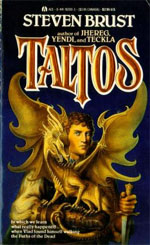 I’m a sucker for non-traditional narrative structures.
I’m a sucker for non-traditional narrative structures.
Start in the middle of the story and then have two narrative tracks — one going forward in time and one going backwards in time — with matching revelations at the end of each track? Awesome.
Six different characters without any apparent connection to each other but experiencing events which are clearly interconnected? Awesome.
In terms of Brust, this trend actually started in Teckla — a novel in which a literal laundry list is used as prelude, omen, and outline. (It’s actually quite difficult to give this proper justice, but it’s really, really clever.)
In Taltos, Brust goes in a completely different direction: He has three different narrative threads, all starring the same character, and all taking place at different times during the character’s life. In some ways, he’s taking the non-linear meta-structure of the series and realizing it in the confines of a single volume.
Of course, the most important thing with a non-traditional narrative structure is not the oddity of the structure — it’s the effectiveness of the use to which it is put. In Taltos, that use is subtle, but effective. A lot of it is about thematic resonance and characterization — I show you X in timeline A and then I show you Y in timeline B. By juxtaposing the two concepts or the two thoughts or the two actions, what conclusions can you draw?
But there’s also a practical side to the structure, as exposition dropped in timeline C will suddenly crop up in timeline B (or even vice versa). This creates, in a very specific way, a complexity of character that isn’t possible in a more traditional narrative structure — because it highlights the fact that a person is not merely a sequence of events or a static entity.
And while the book stands by itself in some regards, the entire narrative is deeply enriched by the knowledge that we — as readers — bear with us from other books. The revelations of Taltos reshape our understanding of events we have already witnessed; and the revelations of previous books (as yet unknown to the Vlad of this story) shape our understanding of Taltos.
That type of multi-layered, interconnected resonance is not easy to create, but it’s very satisfying to read.
All of this is evidence of Brust’s continuing maturation as an artist. And that growth can also be seen in other aspects of the work. For example, one of the comments I made in my reaction to Yendi was that Brust had failed to raise the stakes from the previous volume in the series: “The first time you show me a rocketship? Awesome. The second time you show me a rocketship? Nifty. Now, what are you going to do with it?”
In Teckla, he used the rocketship. In Taltos he uses the rocketship with his left hand while building brand new rocketships with his right hand.
In short, he takes his existing tableau of characters, history, and mythology and builds upon them in new and interesting ways. Simultaneously, he is creating whole new swaths of hitherto unseen mythology which is not only creative in its own right — but which is then immediately pressed into service on a deeper narrative level, as well.
GRADE: B+
Steven Brust
Published: 1988
Publisher: Ace
Cover Price: $7.99
ISBN: 0441182003
Buy Now!











